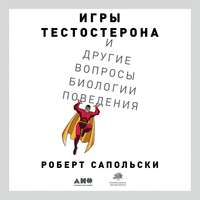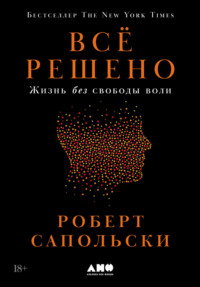
Полная версия
Биология добра и зла. Как наука объясняет наши поступки
72
J. Greene et al., “The Neural Bases of Cognitive Conflict and Control in Moral Judgment,” Neuron 44 (2004): 389; S. McClure et al., “Separate Neural Systems Value Immediate and Delayed Monetary Rewards,” Sci 306 (2004): 503.
73
A. Barbey et al., “Dorsolateral Prefrontal Contributions to Human Intelligence,” Neuropsychologia 51 (2013): 1361.
74
D. Knock et al., “Diminishing Reciprocal Fairness by Disrupting the Right Prefrontal Cortex,” Sci 314(2006): 829.
75
D. Mobbs et al., “A Key Role for Similarity in Vicarious Reward,” Sci 324 (2009): 900; P. Janata et al., “The Cortical Topography of Tonal Structures Underlying Western Music,” Sci 298 (2002): 2167; M. Balter, “Study of Music and the Mind Hits a High Note in Montreal,” Sci 315 (2007): 758.
76
J. Saver and A. Damasio, “Preserved Access and Processing of Social Knowledge in a Patient with Acquired Sociopathy Due to Ventromedial Frontal Damage,” Neuropsychologia 29 (1991): 1241; M. Donoso et al., “Foundations of Human Reasoning in the Prefrontal Cortex,” Sci 344 (2014): 1481; T. Hare, “Exploiting and Exploring the Options,” Sci 344 (2014): 1446; T. Baumgartner et al., “Dorsolateral and Ventromedial Prefrontal Cortex Orchestrate Normative Choice,” Nat Nsci 14 (2011): 1468; A. Bechara, “The Role of Emotion in Decision-Making: Evidence from Neurological Patients with Orbitofrontal Damage,” Brain and Cog 55 (2004): 30.
77
A. Damasio, The Feeling of What Happens: Body and Emotion in the Making of Consciousness (Boston: Harcourt, 1999).
78
M. Koenigs et al., “Damage to the Prefrontal Cortex Increases Utilitarian Moral Judgments,” Nat 446 (2007): 865; B. Thomas et al., “Harming Kin to Save Strangers: Further Evidence for Abnormally Utilitarian Moral Judgments After Ventromedial Prefrontal Damage,” J Cog Nsci 23 (2011): 2186.
79
A. Bechara et al., “Deciding Advantageously Before Knowing the Advantageous Strategy,” Sci 275 (1997): 1293; A. Bechara et al., “Insensitivity to Future Consequences Following Damage to Human Prefrontal Cortex,” Cog 50 (1994): 7.
80
L. Young et al., “Damage to Ventromedial Prefrontal Cortex Impairs Judgment of Harmful Intent,” Neuron 25 (2010): 845.
81
C. Limb and A. Braun, “Neural Substrates of Spontaneous Musical Performance: An fMRI Study of Jazz Improvisation,” PLoS ONE 3 (2008): e1679; C. Salzman and S. Fusi, “Emotion, Cognition, and Mental State Representation in Amygdala and Prefrontal Cortex,” Ann Rev of Nsci 33 (2010): 173.
82
J. Greene et al., “An fMRI Investigation of Emotional Engagement in Moral Judgment,” Sci 293 (2001): 2105; J. Greene et al., “The Neural Bases of Cognitive Conflict and Control in Moral Judgment,” Neuron 44 (2004): 389–400; J. Greene, Moral Tribes: Emotion, Reason, and the Gap Between Us and Them (New York: Penguin, 2013).
83
J. Peters et al., “Induction of Fear Extinction with Hippocampal-Infralimbic BDNF,” Sci 328 (2010): 1288; M. Milad and G. Quirk, “Neurons in Medial Prefrontal Cortex Signal Memory for Fear Extinction,” Nat 420 (2002): 70; M. Milad and G. Quirk, “Fear Extinction as a Model for Translational Neuroscience: Ten Years of Progress,” Ann Rev of Psych 63 (2012): 129; C. Lai et al., “Opposite Effects of Fear Conditioning and Extinction on Dendritic Spine Remodeling,” Nat 483 (2012): 87. Некоторые из недавних работ предполагают включение обоих участков – и вмПФК, и базолатеральной миндалины: A. Adhikari et al., “Basomedial Amygdala Mediates Top-Down Control of Anxiety and Fear,” Nat 527 (2016): 179.
84
K. Ochsner et al., “Rethinking Feelings: An fMRI Study of the Cognitive Regulation of Emotion,” J Cog Nsci 14 (2002): 1215; G. Sheppes and J. Gross, “Is Timing Everything? Temporal Considerations in Emotion Regulation,” PSPR 15 (2011): 319; G. Sheppes and Z. Levin, “Emotion Regulation Choice: Selecting Between Cognitive Regulation Strategies to Control Emotion,” Front Human Neurosci 7 (2013): 179; J. Gross, “Antecedent- and Response-Focused Emotion Regulation: Divergent Consequences for Experience, Expression, and Physiology,” JPSP 74 (1998): 224; J. Gross, “Emotion Regulation: Affective, Cognitive, and Social Consequences,” Psychophysiology 39 (2002): 281; K. Ochsner and J. Gross, “The Cognitive Control of Emotion,” TICS 9 (2005): 242.
85
M. Lieberman et al., “The Neural Correlates of Placebo Effects: A Disruption Account,” NeuroImage 22 (2004): 447; P. Petrovic et al., “Placebo and Opioid Analgesia: Imaging a Shared Neuronal Network,” Sci 295 (2002): 1737.
86
J. Beck, Cognitive Behavior Therapy, 2nd edition (New York: Guilford Press, 2011); P. Goldin et al., “Cognitive Reappraisal Self-Efficacy Mediates the Effects of Individual Cognitive-Behavioral Therapy for Social Anxiety Disorder,” J Consulting Clin Psych 80 (2012): 1034.
87
A. Bechara et al., “Failure to Respond Autonomically to Anticipated Future Outcomes Following Damage to Prefrontal Cortex,” Cerebral Cortex 6 (1996): 215; C. Martin et al., “The Effects of Vagus Nerve Stimulation on Decision-Making,” Cortex 40 (2004): 605.
88
G. Bodenhausen et al., “Negative Affect and Social Judgment: The Differential Impact of Anger and Sadness,” Eur J Soc Psych 24 (1994): 45; A. Sanfey et al., “The Neural Basis of Economic Decision-Making in the Ultimatum Game,” Sci 300 (2003): 1755; K. Gospic et al., “Limbic Justice: Amygdala Involvement in Immediate Rejections in the Ultimatum Game,” PLoS ONE 9 (2011): e1001054.
89
D. Wegner, “How to Think, Say, or Do Precisely the Worst Thing on Any Occasion,” Sci 325 (2009): 58.
90
R. Davidson and S. Begley, The Emotional Life of Your Brain (New York: Hudson Street Press, 2011); A. Tomarken and R. Davidson, “Frontal Brain Activation in Repressors and Nonrepressors,” J Abnormal Psych 103 (1994): 339.
91
A. Ito et al., “The Contribution of the Dorsolateral Prefrontal Cortex to the Preparation for Deception and Truth-Telling,” Brain Res 1464 (2012): 43; S. Spence et al., “A Cognitive Neurobiological Account of Deception: Evidence from Functional Neuroimaging,” Philosophical Transactions of the Royal Soc London Series B 359 (2004): 1755; I. Karton and T. Bachmann, “Effect of Prefrontal Transcranial Magnetic Stimulation on Spontaneous Truth-Telling,” BBR 225 (2011): 209; Y. Yang et al., “Prefrontal White Matter in Pathological Liars,” Brit J Psychiatry 187 (2005): 320.
92
D. Carr and S. Sesack, “Projections from the Rat Prefrontal Cortex to the Ventral Tegmental Area: Target Specificity in the Synaptic Associations with Mesoaccumbens and Mesocortical Neurons,” J Nsci 20 (2000): 3864; M. Stefani and B. Moghaddam, “Rule Learning and Reward Contingency Are Associated with Dissociable Patterns of Dopamine Activation in the Rat Prefrontal Cortex, Nucleus Accumbens, and Dorsal Striatum,” J Nsci 26 (2006): 8810.
93
T. Danjo et al., “Aversive Behavior Induced by Optogenetic Inactivation of Ventral Tegmental Area Dopamine Neurons Is Mediated by Dopamine D2 Receptors in the Nucleus Accumbens,” PNAS 111 (2014): 6455; N. Schwartz et al., “Decreased Motivation During Chronic Pain Requires Long-Term Depression in the Nucleus Accumbens,” Nat 345 (2014): 535.
94
J. Cloutier et al., “Are Attractive People Rewarding? Sex Differences in the Neural Substrates of Facial Attractiveness,” J Cog Nsci 20 (2008): 941; K. Demos et al., “Dietary Restraint Violations Influence Reward Responses in Nucleus Accumbens and Amygdala,” J Cog Nsci 23 (2011): 1952.
95
Сноска: R. Deaner et al., “Monkeys Pay per View: Adaptive Valuation of Social Images by Rhesus Macaques,” Curr Biol 15 (2005): 543.
96
V. Salimpoor et al., “Interactions Between the Nucleus Accumbens and Auditory Cortices Predicts Music Reward Value,” Sci 340 (2013): 216; G. Berns and S. Moore, “A Neural Predictor of Cultural Popularity,” J Consumer Psych 22 (2012): 154; S. Erk et al., “Cultural Objects Modulate Reward Circuitry,” Neuroreport 13 (2002): 2499.
97
A. Sanfey et al., “The Neural Basis of Economic Decision-Making in the Ultimatum Game,” Sci 300 (2003): 1755. Также см. работы: J. Moll et al., “Human Front-Mesolimbic Networks Guide Decisions About Charitable Donation,” PNAS 103 (2006): 15623; W. Harbaugh et al., “Neural Responses to Taxation and Voluntary Giving Reveal Motives for Charitable Donations,” Sci 316 (2007): 1622.
98
D. De Quervain et al., “The Neural Basis of Altruistic Punishment,” Sci 305 (2004): 1254; B. Knutson, “Sweet Revenge?” Sci 305 (2004): 1246.
99
M. Delgado et al., “Understanding Overbidding: Using the Neural Circuitry of Reward to Design Economic Auctions,” Sci 321 (2008): 1849; E. Maskin, “Can Neural Data Improve Economics?” Sci 321 (2008): 1788.
100
H. Takahasi et al., “When Your Gain Is My Pain and Your Pain Is My Gain: Neural Correlates of Envy and Schadenfreude,” Sci 323 (2009): 890; K. Fliessbach et al., “Social Comparison Affects Reward-Related Brain Activity in the Human Ventral Striatum,” Sci 318 (2007): 1305.
101
W. Schultz, “Dopamine Signals for Reward Value and Risk: Basic and Recent Data,” Behav and Brain Functions 6 (2010): 24.
102
J. Cooper et al., “Available Alternative Incentives Modulate Anticipatory Nucleus Accumbens Activation,” SCAN 4 (2009): 409; D. Levy and P. Glimcher, “Comparing Apples and Oranges: Using Reward-Specific and Reward-General Subjective Value Representation in the Brain,” J Nsci 31 (2011): 14693.
103
P. Tobler et al., “Adaptive Coding of Reward Value by Dopamine Neurons,” Sci 307 (2005): 1642.
104
W. Schultz, “Dopamine Signals for Reward Value and Risk: Basic and Recent Data,” Behav and Brain Functions 6 (2010): 24; J. Cohen et al., “Neuron-Type-Specific Signals for Reward and Punishment in the Central Tegmental Area,” Nat 482 (2012): 85; J. Hollerman and W. Schultz, “Dopamine Neurons Report an Error in the Temporal Prediction of Reward During Learning,” Nat Nsci 1 (1998): 304; A. Brooks et al., “From Bad to Worse: Striatal Coding of the Relative Value of Painful Decisions,” Front Nsci 4 (2010): 1.
105
B. Knutson et al., “Neural Predictors of Purchases,” Neuron 53 (2007): 147.
106
P. Sterling, “Principles of Allostasis: Optimal Design, Predictive Regulation, Pathophysiology and Rational Therapeutics,” in Allostasis, Homeostasis, and the Costs of Adaptation, ed. J. Schulkin (Cambridge, MA: MIT Press, 2004).
107
B. Knutson et al., “Anticipation of Increasing Monetary Reward Selectively Recruits Nucleus Accumbens,” J Nsci 21 (2001): RC159.
108
G. Stuber et al., “Reward-Predictive Cues Enhance Excitatory Synaptic Strength onto Midbrain Dopamine Neurons,” Sci 321 (2008): 1690; A. Luo et al., “linkcing Context with Reward: A Functional Circuit from Hippocampal CA3 to Ventral Tegmental Area,” Sci 33 (2011): 353; J. O’Doherty, “Reward Representations and Reward-Related Learning in the Human Brain: Insights from Neuroimaging,” Curr Opinions in Neurobiol 14 (2004): 769; M. Cador et al., “Involvement of the Amygdala in Stimulus-Reward Associations: Interaction with the Ventral Striatum,” Nsci 30 (1989): 77; J. Britt et al., “Synaptic and Behavioral Profile of Multiple Glutamatergic Inputs to the Nucleus Accumbens,” Neuron 76 (2012): 790; G. Stuber et al., “Optogenetic Modulation of Neural Circuits That Underlie Reward Seeking,” BP 71 (2012): 1061; F. Ambroggi et al., “Basolateral Amygdala Neurons Facilitate Reward-Seeking Behavior by Exciting Nucleus Accumbens Neurons,” Neuron 59 (2008): 648.
109
S. Hyman et al., “Neural Mechanisms of Addiction: The Role of Reward-Related Learning and Memory,” Ann Rev of Nsci 29 (2006): 565; B. Lee et al., “Maturation of Silent Synapses in Amygdala-Accumbens Projection Contributes to Incubation of Cocaine Craving,” Nat Nsci 16 (2013): 1644. Обсуждение навязчивых поведенческих актов как одного из видов болезненной зависимости: S. Rauch and W. Carlezon, “Illuminating the Neural Circuitry of Compulsive Behaviors,” Sci 340 (2013): 1174; S. Ahmari et al., “Repeated Cortico-Striatal Stimulation Generates Persistent OCD-like Behavior,” Sci 340 (2013): 1234; E. Burguiere et al., “Optogenetic Stimulation of Lateral Orbitofronto-Striatal Pathway Suppresses Compulsive Behaviors,” Sci 340 (2013): 1243.
110
S. Flagel et al., “A Selective Role for Dopamine in Stimulus-Reward Learning,” Nat 469 (2011): 53; K. Burke et al., “The Role of the Orbitofrontal Cortex in the Pursuit of Happiness and More Specific Rewards,” Nat 454 (2008): 340.
111
P. Tobler et al., “Adaptive Coding of Reward Value by Dopamine Neurons,” Sci 307 (2005): 1642; C. Fiorillo et al., “Discrete Coding of Reward Probability and Uncertainty by Dopamine Neurons,” Sci 299 (2003): 1898.
112
B. Knutson et al., “Distributed Neural Representation of Expected Value,” J Nsci 25 (2005): 4806; M. Stefani and B. Moghaddam, “Rule Learning and Reward Contingency Are Associated with Dissociable Patterns of Dopamine Activation in the Rat Prefrontal Cortex, Nucleus Accumbens, and Dorsal Striatum,” J Nsci 26 (2006): 8810.
113
R. Habib and M. Dixon, “Neurobehavioral Evidence for the “Near-Miss” Effect in Pathological Gamblers,” J the Exp Analysis of Behav 93 (2010): 313; M. Hsu et al., “Neural Systems Responding to Degrees of Uncertainty in Human Decision-Making,” Sci 310 (2006): 1680.
114
A. Braun et al., “Dorsal Striatal Dopamine Depletion Impairs Both Allocentric and Egocentric Navigation in Rats,” Neurobiol of Learning and Memory 97 (2012): 402; J. Salamone, “Dopamine, Effort, and Decision Making,” Behavioral Nsci 123 (2009): 463; I. Whishaw and S. Dunnett, “Dopamine Depletion, Stimulation or Blockade in the Rat Disrupts Spatial Navigation and Locomotion Dependent upon Beacon or Distal Cues,” BBR 18 (1985): 11; J. Salamone and M. Correa, “The Mysterious Motivational Functions of Mesolimbic Dopamine,” Neuron 76 (2012): 470; H. Tsai et al., “Phasic Firing in Dopaminergic Neurons Is Sufficient for Behavioral Conditioning,” Sci 324 (2009): 1080; P. Phillips et al., “Sub-second Dopamine Release Promotes Cocaine Seeking,” Nat 422 (2003): 614; M. Pessiglione et al., “Dopamine-Dependent Prediction Errors Underpin Reward-Seeking Behavior in Humans,” Nat 442 (2008): 1042.
115
К сноске: M. Numan and D. Stoltzenberg, “Medial Preoptic Area Interactions with Dopamine Neural systemsin the Control of the Onset and Maintenance of Maternal Behavior in Rats,” Front Neuroendo 30 (2009): 46.
116
S. McClue et al., “Separate Neural Systems Value Immediate and Delayed Monetary Rewards,” Sci 306 (2004): 503; J. Jennings et al., “Distinct Extended Amygdala Circuits for Divergent Motivational States,” Nat 496 (2013): 224.
117
M. Howe et al., “Prolonged Dopamine Signaling in Striatum Signals Proximity and Value of Distant Rewards,” Nat 500 (2013): 575; Y. Niv, “Dopamine Ramps Up,” Nat 500 (2013): 533.
118
W. Schultz, “Subjective Neuronal Coding of Reward: Temporal Value Discounting and Risk,” Eur J Nsci 31 (2010): 2124; S. Kobayashi and W. Schultz, “Influence of Reward Delays on Responses of Dopamine Neurons,” J Nsci 28 (2008): 7837; S. Kim et al., “Prefrontal Coding of Temporally Discounted Values During Intertemporal Choice,” Neuron 59 (2008): 161; M. Roesch and C. Olson, “Neuronal Activity in Orbitofrontal Cortex Reflects the Value of Time,” J Neurophysiology 94 (2005): 2457; M. Bermudez and W. Schultz, “Timing in Reward and Decision Processes,” Philosophical Trans of the Royal Soc of London B 369 (2014): 20120468; B. Figner et al., “Lateral Prefrontal Cortex and Self-Control in Intertemporal Choice,” Nat Nsci 13 (2010): 538; K. Jimura et al., “Impulsivity and Self-Control During Intertemporal Decision Making linkced to the Neural Dynamics of Reward Value Representation,” J Nsci 33 (2013): 344; S. McClure et al., “Time Discounting for Primary Rewards,” J Nsci 27, 5796.
119
K. Ballard and B. Knutson, “Dissociable Neural Representations of Future Reward Magnitude and Delay During Temporal Discounting,” Neuroimage 45 (2009): 143.
120
A. Lak et al., “Dopamine Prediction Error Responses Integrate Subjective Value from Different Reward Dimensions,” PNAS 111 (2014): 2343.
121
V. Noreika et al., “Timing Deficits in Attention-Deficit / Hyperactivity Disorder (ADHD): Evidence from Neurocognitive and Neuroimaging Studies,” Neuropsychologia 51 (2013): 235; A. Pine et al., “Dopamine, Time, and Impulsivity in Humans,” J Nsci 30 (2010): 8888; W. Schultz, “Potential Vulnerabilities of Neuronal Reward, Risk, and Decision Mechanisms to Addictive Drugs,” Neuron 69 (2011): 603.
122
G. Brown et al., “Aggression in Humans Correlates with Cerebrospinal Fluid Amine Metabolites,” Psychiatry Res 1 (1979): 131; M. Linnoila et al., “Low Cerebrospinal Fluid 5-Hydroxyindoleacetic Acid Concentration Differentiates Impulsive from Nonimpulsive Violent Behavior,” Life Sci 33 (1983): 2609; P. Stevenson and K. Schildberger, “Mechanisms of Experience Dependent Control of Aggression in Crickets,” Curr Opinion in Neurobiol 23 (2013): 318; P. Fong and A. Ford, “The Biological Effects of Antidepressants on the Molluscs and Crustaceans: A Review,” Aquatic Toxicology 151 (2014): 4.
123
M. Linnoila et al., “Low Cerebrospinal Fluid 5-Hydroxyindoleacetic Acid Concentration Differentiates Impulsive from Nonimpulsive Violent Behavior,” Life Sci 33 (1983): 2609; J. Higley et al., “Excessive Mortality in Young Free- Ranging Male Nonhuman Primates with Low Cerebrospinal Fluid 5-Hydroxyindoleacetic Acid Concentrations,” AGP 53 (1996): 537; M. Åsberg et al., “5-HIAA in the Cerebrospinal Fluid: A Biochemical Suicide Predictor?” AGP 33 (1976): 1193; M. Bortolato et al., “The Role of the Serotonergic System at the Interface of Aggression and Suicide,” Nsci 236 (2013): 160.
124
H. Clarke et al., “Cognitive Inflexibility After Prefrontal Serotonin Depletion,” Sci 304 (2004): 878; R. Wood et al., “Effects of Tryptophan Depletion on the Performance of an Iterated PD Game in Healthy Adults,” Neuropsychopharmacology 1 (2006): 1075.
125
J. Dalley and J. Roiser, “Dopamine, Serotonin and Impulsivity,” Nsci 215 (2012): 42; P. Redgrave and R. Horrell, “Potentiation of Central Reward by Localized Perfusion of Acetylcholine and 5-Hydroxytryptamine,” Nat 262 (1976): 305; A. Harrison and A. Markou, “Serotonergic Manipulations Both Potentiate and Reduce Brain Stimulation Reward in Rats: Involvement of Serotonin-1A Receptors,” JPET 297 (2001): 316.
126
A. Duke, “Revisiting the Serotonin-Aggression Relation in Humans: A Meta-analysis,” Psych Bull 139 (2013): 1148.
127
A. Gopnik, “The New Neuro-Skeptics,” New Yorker, September 9, 2013.
128
C. Bukach et al., “Beyond Faces and Modularity: The Power of an Expertise Framework,” TICS 10 (2006): 159.
129
Жестокие матери и работы антибихевиористов: D. Maestripieri et al., “Neurobiological Characteristics of Rhesus Macaque Abusive Mothers and Their Relation to Social and Maternal Behavior,” Nsci Biobehav Rev 29 (2005): 51; R. Sullivan et al., “Ontogeny of Infant Fear Learning and the Amygdala,” in Cognitive Neuroscience IV, ed. M. Gazzaniga (Cambridge, MA: MIT Press, 2009), 889.
130
Голоса панд: B. Charlton et al., “Vocal Discrimination of Potential Mates by Female Giant Pandas (Ailuropoda melanoleuca),” Biol Lett 5 (2009): 597. Голоса женщин: G. Bryant and M. Haselton, “Vocal Cues of Ovulation in Human Females,” Biol Lett 5 (2009): 12; к сноске: J. Knight, “When Robots Go Wild,” Nat 434 (2005): 954.
131
К сноске: H. Herzog, Some We Love, Some We Hate, Some We Eat: Why It’s So Hard to Think Straight About Animals (New York: Harper, 2010).
132
Коммуникация за счет вибраций: P. Hill, Vibrational Communication in Animals (Cambridge, MA: Harvard University Press, 2008). Вибрирующие сигналы и эхолокация у летучих мышей: A. Corcoran and W. Conner, “Bats Jamming Bats: Food Competition Through Sonar Interference,” Sci 346 (2014): 745. Щекотание крыс: J. Panksepp, “Beyond a Joke: From Animal Laughter to Human Joy?” Sci 308 (2005): 62.
133
Обзор проблемы о соотношении подсознательной и осознаваемой сенсорной информации, а также о том, что выявляемый континуум может быть ошибочным: T. Marteau et al., “Changing Human Behavior to Prevent Disease: The Importance of Targeting Automatic Processes,” Sci 337 (2012): 1492.
134
Картофельные чипсы: M. Zampini and C. Spence, “Assessing the Role of Sound in the Perception of Food and Drink,” Chemical Senses 3 (2010): 57. K. Edwards, “The Interplay of Affect and Cognition in Attitude Formation and Change,” JPSP 59 (1990): 212.
135
Превосходный обзор по теме: J. Kubota et al. “The Neuroscience of Race,” Nat Nsci 15 (2012): 940; чтобы получить хороший обзор по всей теме, см.: D. Ariely, Predictably Irrational: The Hidden Forces That Shape Our Decisions (New York HarperCollins, 2008).
136
T. Ito and G. J. Urland, “Race and Gender on the Brain: Electrocortical Measures of Attention to the Race and Gender of Multiply Categorizable Individuals,” JPSP 85 (2003): 616. Здесь добротный обзор работ, в которых изучаются внутренние установки: B. Nosek et al., “Implicit Social Cognition: From Measures to Mechanisms,” TICS 15 (2011): 152.
137
A. Olsson et al., “The Role of Social Groups in the Persistence of Learned Fear,” Sci 309 (2005): 785.













